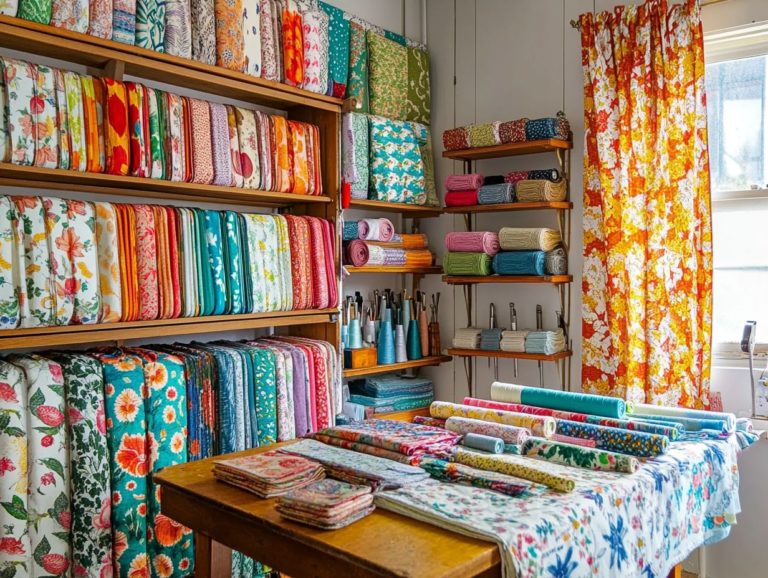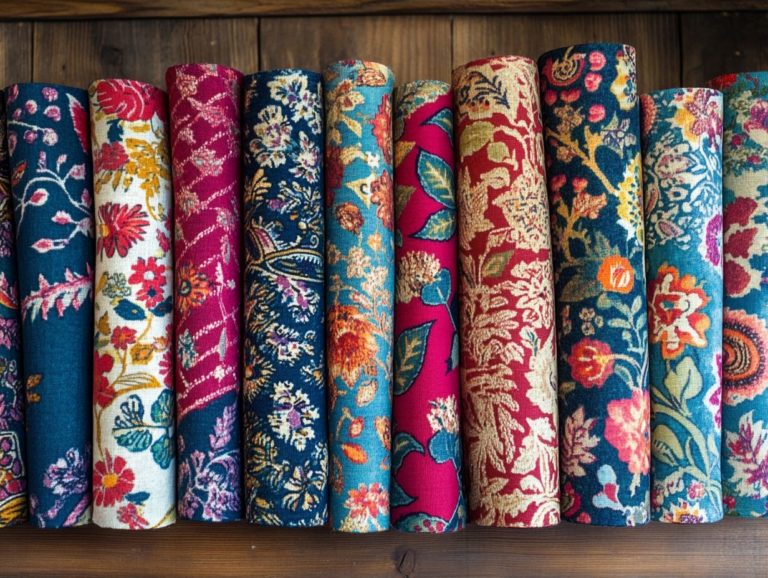The Benefits of Using Organic Vintage Fabrics
In a world that increasingly prioritizes sustainability, organic vintage fabrics and environmentally friendly fashion present themselves as elegant and eco-conscious options for discerning consumers like you.
These distinctive textiles not only captivate with their aesthetic appeal but also provide a wealth of benefits for the environment, your personal health, and ethical consumption. By choosing organic vintage fabrics, you actively reduce your carbon footprint and champion fair trade practices, transforming the essence of sustainable shopping while supporting sustainable practices.
Get ready to transform your wardrobe with these amazing finds!
Contents
- Key Takeaways:
- What Makes Organic Vintage Fabrics Special?
- Environmental Benefits of Organic Vintage Fabrics
- Health Benefits of Organic Vintage Fabrics
- Ethical Considerations of Using Organic Vintage Fabrics
- How to Incorporate Organic Vintage Fabrics into Your Wardrobe
- Frequently Asked Questions
- What are the benefits of using organic vintage fabrics?
- How are organic vintage fabrics better for the environment?
- Are organic vintage fabrics more durable?
- Do organic vintage fabrics have any health benefits?
- Are organic vintage fabrics more expensive?
- What makes vintage fabrics different from regular fabrics?
Key Takeaways:
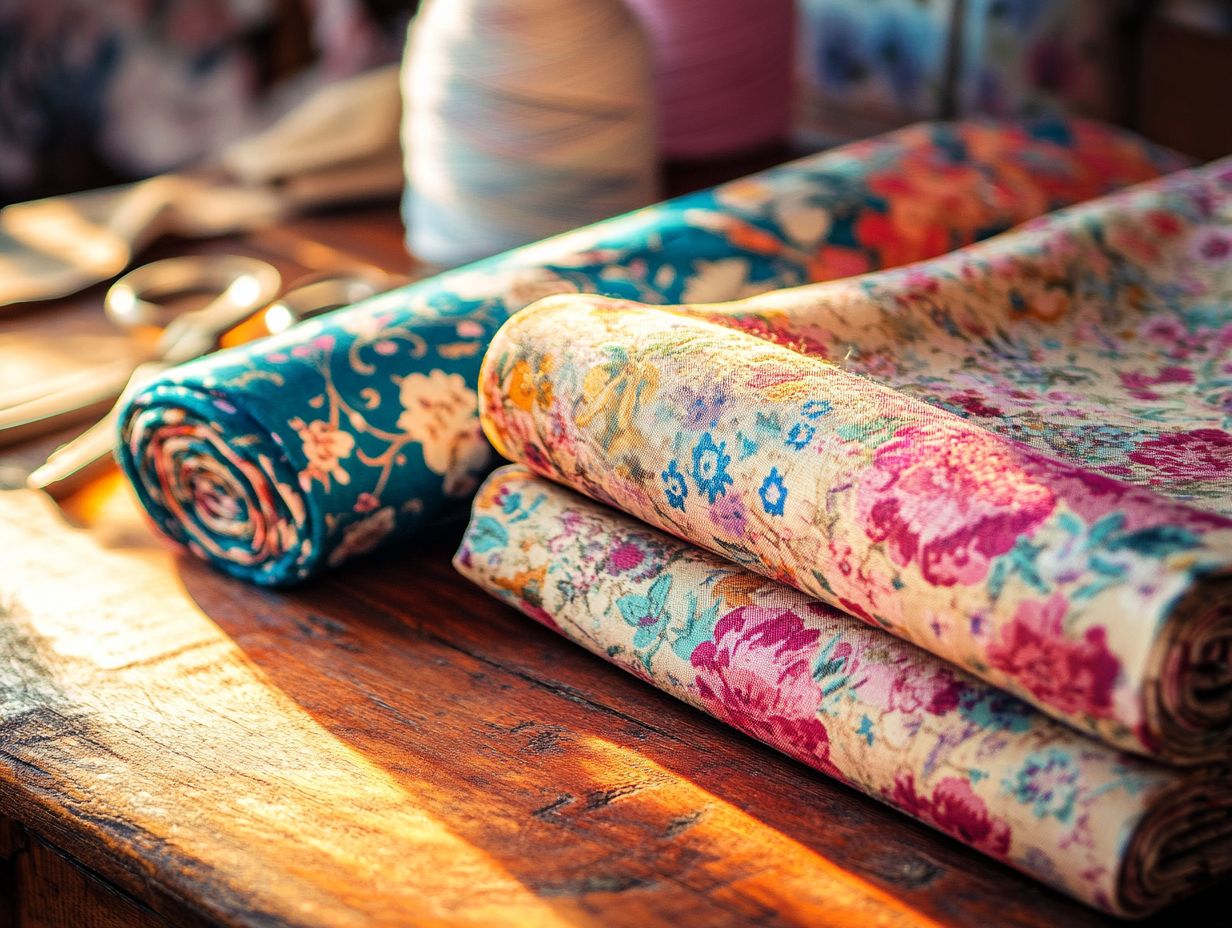
- Organic vintage fabrics help reduce your carbon footprint and support sustainable farming.
- Choosing organic vintage fabrics offers health benefits, as they are free from harmful chemicals and improve indoor air quality.
- Opting for organic vintage fabrics promotes fair trade and ethical production, positively impacting the fashion industry.
What Makes Organic Vintage Fabrics Special?
Organic vintage fabrics embody a remarkable blend of sustainability and style, crafted from natural resources and produced through environmentally friendly fashion methods. You ll often find these fabrics made from materials like organic cotton, hemp, linen, and jute, all of which boast Global Organic Textile Standard (GOTS) certification, which verifies organic material.
By opting for these textiles, you play a crucial role in reducing textile waste and the environmental footprint of clothing production. Embracing vintage textiles not only supports local economies and fair working conditions but also allows you to enjoy unique designs that withstand the test of time, including sustainable fabrics that contribute to environmental preservation.
This movement champions a circular economy, which means reusing materials to cut down on waste, minimizing reliance on fast fashion.
Environmental Benefits of Organic Vintage Fabrics
Organic vintage fabrics offer many environmental benefits. They help cut down on textile waste and greenhouse gas emissions linked to traditional clothing production while minimizing environmental impact.
By opting for eco-friendly fashion choices, such as Tencel lyocell and deadstock fabrics, you actively support sustainable practices that prioritize the well-being of our planet while promoting a circular economy within the textile industry. Your choices can make a remarkable difference.
Reducing Carbon Footprint
Reducing your carbon footprint becomes an effortless advantage when you choose organic vintage fabrics, as they typically require less energy and fewer resources compared to the mass production methods employed by fast fashion brands.
This reduction comes from the meticulous sourcing and harvesting of natural resources, which generally utilize minimal synthetic inputs and avoid harmful chemicals, ensuring the use of hypoallergenic materials. Since these fabrics are often pre-loved, their production cycles are shorter, resulting in fewer emissions from raw material extraction.
The lifecycle of sustainable fabrics emphasizes circularity and longevity, allowing them to remain useful well beyond a single season unlike the fleeting trends that dominate fast fashion.
By embracing such eco-friendly materials, you can actively support mindful consumption practices that prioritize quality over quantity, ultimately nurturing a more sustainable fashion ecosystem.
Now is the time to embrace eco-friendly materials and make a positive change in the fashion world! Join the movement for sustainable fashion today!
Supporting Sustainable Agriculture
Supporting sustainable agriculture through the use of organic vintage fabrics enhances your environmental footprint and champions fair working conditions for farmers and laborers.
These sustainable materials come from farms committed to eco-friendly practices, such as regenerative farming techniques and the cultivation of organic cotton. These practices enrich soil health and boost biodiversity. By opting for organic cotton and similar alternatives, you re making a positive change and actively contributing to local economies. This allows farmers to earn fair wages and invest back into their communities.
Ethical considerations are paramount in this movement. Numerous brands like Patagonia and Stella McCartney prioritize transparency in their supply chains and forge partnerships with co-ops that uphold labor rights. Companies like Eileen Fisher and Reformation embody this ethos, demonstrating the vital importance of making conscious fashion choices that resonate with both environmental integrity and social responsibility.
Health Benefits of Organic Vintage Fabrics
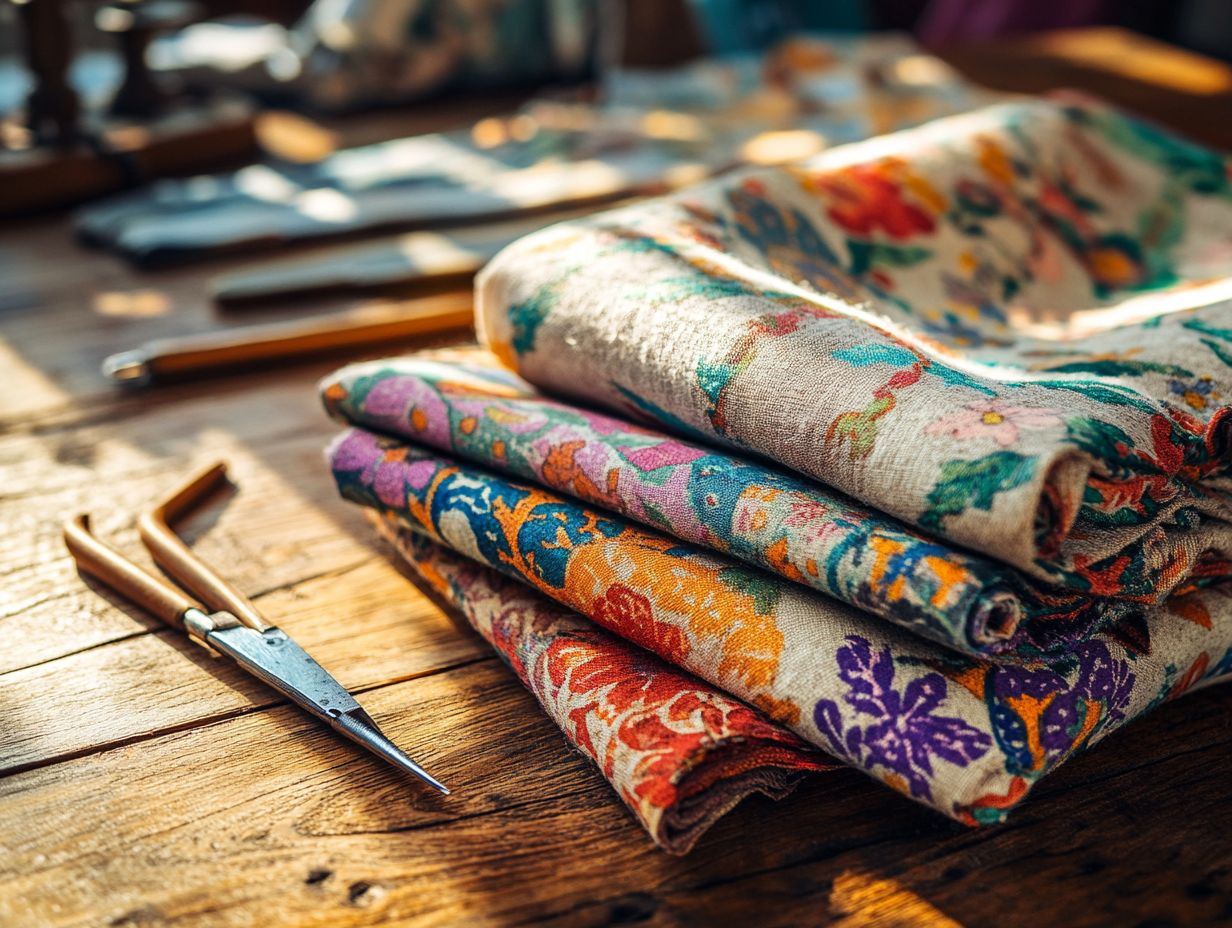
Organic vintage fabrics, made from skin-friendly fabrics such as organic cotton and natural fibers, offer health benefits that elevate comfort and well-being. This is especially important for those with sensitive skin.
By choosing these carefully crafted textiles, you embrace superior quality and prioritize your health and comfort in your daily life.
Reducing Exposure to Harmful Chemicals
Choosing organic vintage fabrics significantly minimizes your exposure to harmful chemicals lurking in conventional textile production. This ensures a healthier wardrobe.
This choice prioritizes your well-being and champions a more sustainable approach to fashion. Organic cotton and other natural materials are free from toxic dyes and harmful chemicals, offering comfort without compromising your health.
As awareness grows around chemical exposure, you’ll notice a compelling shift towards eco-friendly fashion choices. Embrace vintage clothing that is stylish and responsible. By choosing these sustainable options, you contribute to a cleaner planet while curating a wardrobe that reflects your values, harmonizing health, comfort, and environmental consciousness.
Improving Indoor Air Quality
Incorporating organic vintage fabrics into your wardrobe significantly enhances your indoor air quality. Unlike synthetic textiles, these materials don t emit volatile organic compounds (VOCs), substances that can harm indoor air quality. This lets you breathe easier in your own space.
This choice elevates your personal style and plays a crucial role in fostering a healthier living environment. This is especially important for conscious consumers aiming for better air quality. For many, especially those with respiratory sensitivities or allergies, natural textiles offer a breath of fresh air literally since they are free from harmful chemicals and toxins.
By choosing organic cotton and similar materials, you create a safer and more comfortable atmosphere at home. This mindful selection helps reduce irritants in your indoor space, transforming it into a sanctuary for everyone. This is particularly beneficial for those with sensitive skin who are more vulnerable to airborne pollutants.
Ethical Considerations of Using Organic Vintage Fabrics
When you delve into the realm of organic vintage fabrics, consider the ethical dimensions involved. Embrace fair trade practices and ensure that production processes uphold ethical standards.
By sourcing materials responsibly and treating workers with the respect they deserve, you contribute to a more sustainable and just industry that supports local economies.
Supporting Fair Trade Practices
Supporting fair trade practices is essential when selecting organic vintage fabrics. This ensures workers are compensated fairly and work in safe, ethical conditions.
This commitment uplifts individual artisans and their communities while nurturing a sustainable economy. When you invest in local artisans, you promote the preservation of traditional crafts and skills, enriching the cultural heritage of the textile industry.
Brands that prioritize ethical production often maintain transparency about their sourcing and manufacturing processes, empowering you to make informed choices.
Every conscious purchase contributes to a ripple effect that encourages responsible practices and empowers marginalized workers, underscoring the profound impact of fair trade practices on global communities.
Promoting Ethical Production

Promoting ethical production in fashion inspires brands to adopt sustainable practices. By choosing eco-friendly fashion brands that champion sustainability, you send a powerful message about the importance of responsible practices. This collective demand can ignite substantial transformation, prompting more companies to reevaluate their production methods and supply chains.
When you prioritize ethical consumption, you create a ripple effect that motivates brands to innovate and adopt greener solutions, fostering a culture of accountability and social responsibility within the industry.
How to Incorporate Organic Vintage Fabrics into Your Wardrobe
Incorporating organic vintage fabrics into your wardrobe elevates your style while supporting sustainability. This choice showcases unique designs and champions eco-friendly fashion practices, ensuring your fashion statements are both distinctive and responsible.
Tips for Shopping and Styling
When shopping for organic vintage fabrics, look for quality garments that feature unique designs and environmentally friendly fashion standards. This journey highlights the allure of sustainable fashion.
To ensure the pieces you select are of the highest quality, examine the labels for information regarding their organic status and care instructions. Familiarizing yourself with various fabric types from soft cottons to luxurious silks empowers you to make informed decisions, especially considering the impact of vintage textiles on eco-friendly design.
Seek out reputable sellers, whether they be vintage shops known for their integrity or online marketplaces with dependable seller ratings. This approach enhances your shopping experience.
Once you’ve acquired these classic fabrics, styling them with modern staples becomes a breeze. Imagine pairing an organic cotton dress with contemporary ankle boots or elegantly layering a vintage silk scarf over a simple turtleneck. These combinations elevate your outfit and showcase the versatility of your treasured finds, while also highlighting the role of vintage fabrics in sustainable decor.
Frequently Asked Questions
What are the benefits of using organic vintage fabrics?
Using organic vintage fabrics is beneficial for both the environment and your health. These fabrics are made from natural materials that are grown without harmful chemicals, making them safer for the planet and your skin.
How are organic vintage fabrics better for the environment?
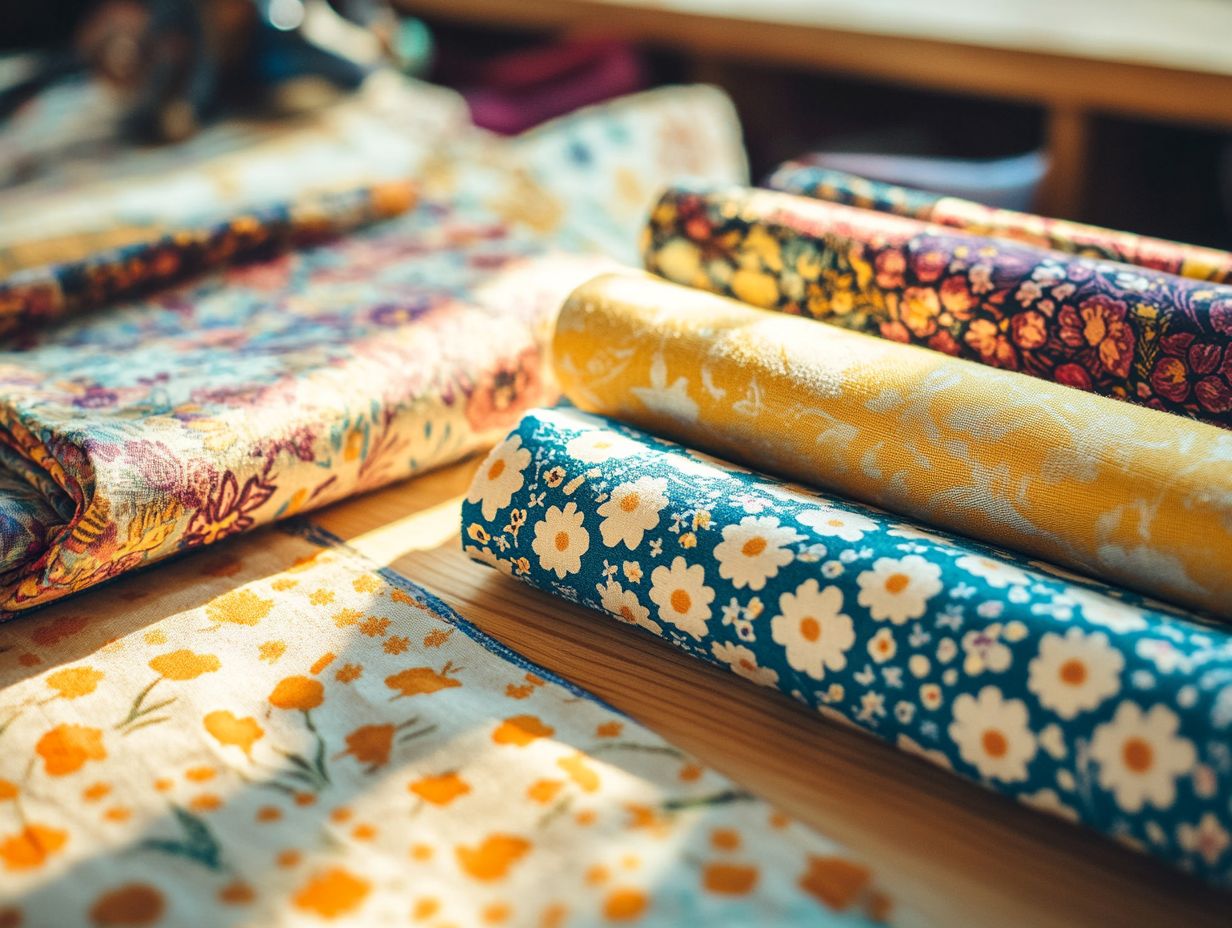
Organic fabrics are grown and processed using sustainable methods that do not harm the environment. This means no toxic chemicals are released into the air or water, and the production process has a lower carbon footprint compared to conventional fabrics.
Are organic vintage fabrics more durable?
Yes, organic vintage fabrics are often more durable than conventional ones.
They are made from high-quality natural materials, which aren’t weakened by harsh chemicals.
Do organic vintage fabrics have any health benefits?
Using organic vintage fabrics positively impacts your health.
They’re free from harmful chemicals that can irritate the skin, making them ideal for sensitive individuals.
Are organic vintage fabrics more expensive?
Organic vintage fabrics may cost a bit more than regular fabrics.
However, investing in high-quality, sustainable materials means they last longer, saving you money over time.
What makes vintage fabrics different from regular fabrics?
Vintage fabrics are usually made from natural materials and created using traditional methods.
This gives them a unique charm and a smaller environmental footprint.


